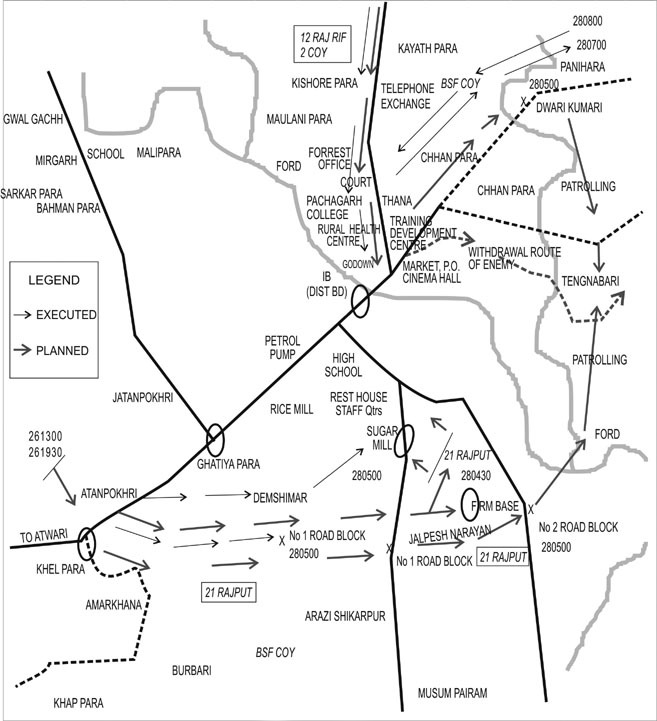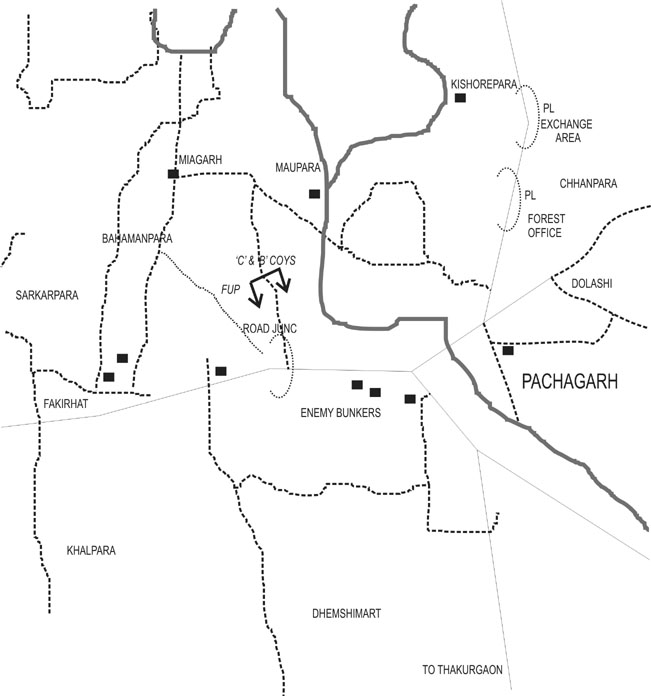
Not to Scale
34 Punjab of Pakistan (Reece and Support Battalion) was opposing 71 Brigade in Pachagarh.
Our Brigade Plan
The plan for the capture of Pachagarh in nutshell, had envisaged encirclement and siege of the town, accompanied by an outer ring closing in towards the centre of the town. This action was to be reinforced by three road blocks for cutting off the enemy withdrawal routes.
In the initial phase, 7 Maratha Light Infantry (Maratha LI), going in from the North-west, was required to tackle the Pachagarh Railway Station and road junction immediately North of it. This operation was to be completed by 0500 hours on 27 November 1971 and they were, therefore, required to tackle the bridge on Karatoya River and East Pakistan Rifles (EPR) Company HQ located South of the bridge. In the exploitation phase they were required to establish a link-up towards the North with 12 Raj Rif and the BSF elements. This last part of their operation was scheduled to be completed by 1200 hours on 28 November 1971.
Simultaneously, 21 Rajput moving from the same direction, but further to the South, were assigned the task of capturing Fakirhat Bridge by 2100 hours on 26 November and thence go in for the Sugar Mill and Staff Quarters in the Southern part of the town, completing operations by 1000 hours on 28 November 1971. This unit was required thereafter to link-up with the Marathas in the area of EPR Company HQ by 1200 hours on 28 November 1971. It was also assigned the task of establishing two road blocks to complete the encirclement from south and east. Road Block No 1 was to be established on Pachagarh – Boda Road and Road Block No 2 on Pachagarh – Debiganj Road.
From the North, after the capture of Amarkhana BOP, 12 Raj Rif, less two companies along with one BSF company were to advance from Jagdalhat onto the Northern outskirts of Pachagarh town, with the aim of diverting the defender’s attention and put pressure on him from this direction, thereby dividing his forces and making the task of our attacking battalions easier. This force was also required to establish Road Block No 3 in the East. This road block, in conjunction with the other two was meant to seal off the enemy’s withdrawal route(s).

Not to Scale
26 November was the ‘D’ Day and the time available till then was used for tying up loose ends and deployment of guns. Thus, the guns of 40 Medium Regiment were deployed near the Brigade HQ in Area Dassapara on 24 November and the two Air Observation Post (AirOP) helicopters, which were in direct support for this operation, commenced engaging the enemy with artillery fire soon thereafter.
With planning completed and orders issued, the units went about their task of collecting information and drawing up detailed plans. Reconnaissance was carried out in civilian clothes along with the Mukti Bahini, ‘Lungi & Kurta’ having been adopted as the dress for patrolling. The International Border could now be crossed and the civil population which had crossed over to India, as well as the Mukti Bahini personnel, were found to be useful as they provided guides, interpreters and valuable information of the area of operations.
Execution of Brigade Plan
The operations of 7 Maratha LI generally proceeded as planned, while 21 Rajput deviated from the original plan during the conduct of operations. The firm base of unit was planned to be established in area Jalpesh Narayani, nearly 2 km away from the one which was actually established at Arazi Shakarpur.
None of the three ‘road blocks’ reached their planned destination. This allowed the enemy to escape as the ring that was to encircle its troops at Tenganabari could not be established.
These are the imponderables of war and plans rarely proceed as visualized. However, the Brigade of the Year 71 Mountain Brigade – now a group had scored its first major victory and was poised to advance on to Thakurgaon.




